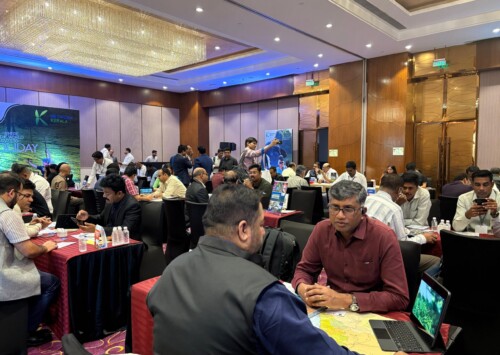From Carbon to UI: Indian cinema’s hidden dystopian stories
Films that imagine the future through today’s challenges.

India has produced its own dystopian stories that explore how the world might look if we continue on our current path,
Indian cinema is usually known for its action, romance, war and occasionally thrillers, but amidst their dominance and under the radar, dystopian films have quietly made a place for themselves, correlating future with factors which govern the present. Here are five such films.

India has produced its own dystopian stories that explore how the world might look if we continue on our current path,
Action, romance, war, historical drama and occasionally, suspense thrillers these are the genres that have long defined Indian cinema. The industry has built its legacy on stories that make audiences laugh, tug at their heartstrings or stir a deep sense of pride in the nation. Whether through grand love stories, heroic battles, or patriotic narratives, Indian films continue to resonate with emotion and cultural pride.
But behind these well-known genres, another has quietly existed, the dystopian genre. Mostly seen in English-language films and not very common elsewhere, India has produced its own dystopian stories that explore how the world might look if we continue on our current path, or imagine what the future could hold.
Here are five lesser-known films that, in their own way, attempt to imagine the future by reflecting on present-day realities.
Carbon: The Story of Tomorrow, 2017
In 2017, a short film titled Carbon: The Story of Tomorrow was released on YouTube, using the dystopian genre to spotlight India’s growing environmental crisis.
Featuring Jacky Bhagnani, Nawazuddin Siddiqui, Prachi Desai and Yashpal Sharma, the film transports viewers to a bleak version of Delhi in the year 2067, a city choked by pollution, where oxygen is scarce and survival comes at a price.
At the centre of the story is a man named Random, who lives with an artificial heart in a world where basic elements like air and water have become luxuries. Desperate to survive, he gets involved in an illegal oxygen deal that spirals out of control. The film uses this premise to highlight the commodification of oxygen and the harsh consequences of environmental neglect.
By contrasting the natural world of 2017 with the grim, artificial future of 2067, Carbon delivers a powerful message, if we continue to pollute our planet and destroy its forests, the air we breathe may one day be sold in black markets, and human lives may depend on machines to do what nature once offered freely.
By humanising critical issues like air pollution and environmental degradation, often reduced to statistics or discussed only during annual pollution spikes, the film resonated with both, the audiences and critics.
The film’s grounded portrayal of a future shaped by today’s negligence struck a chord, with critics praising the film for its effective portrayal of present-day socio-political dynamics and its ability to project them into a future nearly 50 years ahead.
Directed by Maitrey Bajpai and Ramiz Ilham Khan, the film quickly gained traction online, garnering nearly 5.6 million views on YouTube in a short span, according to news reports.
Anukul, 2017
While Carbon: The Story of Tomorrow imagines a future where environmental collapse has turned oxygen into a luxury commodity, another compelling short film tackles a different dystopian dilemma: the rise of machines. Anukul, a 21-minute short available on YouTube, dives into the delicate and dangerous balance between humans and androids.
Based on a short story by legendary filmmaker and writer Satyajit Ray, Anukul is brought to life by director Sujoy Ghosh and stars Saurabh Shukla and Parambrata Chatterjee in pivotal roles. Set in a futuristic Kolkata where androids are steadily replacing human labour, the film follows Nikunj, a mild-mannered teacher who decides to hire an android housekeeper named Anukul.
What begins as a quiet coexistence takes a dark turn when Nikunj’s hot-headed cousin, Ratan, recently unemployed after being replaced by a robot, enters the picture. His growing resentment towards Anukul culminates in a violent outburst, forcing the Android to respond in a way that blurs the lines between programmed obedience and moral judgment.
The film skillfully explores themes of technological advancement, artificial intelligence, and the emotional and ethical consequences of human-robot relationships. Ghosh’s restrained yet unsettling direction paints a chilling vision of a society on the brink of losing its humanity to the very machines it created.
Critics across India praised the film for its nuanced storytelling and eerie atmosphere. Unsurprisingly, Anukul struck a chord with audiences too it garnered over 100,000 views within just 24 hours of its release, a testament to the public’s growing fascination with stories that question our future with technology.
Jil Jung Juk, 2016
Going beyond short films, Tamil cinema ventured into futuristic storytelling with full-length features as early as 2016. One notable attempt was Jil Jung Juk, a dystopian comedy that imagined how the world might look 20-30 years ahead. Set in a chaotic version of 2020, the film explores a future where petrol is scarce, the economy is unstable, and corruption continues unchecked.
Blending dark humour with a stylised dystopian setting, the story revolves around three eccentric characters, Jil, Jung, and Juk, who are hired by a drug lord, Dheivanayagam, to transport a car coated in cocaine. What follows is a wild, visually striking journey that critiques present-day issues like inequality and systemic failure through satire and absurdity.
Featuring Siddharth, Santhosh Kumar, and Atharva Murthy in key roles, the film earned attention for its distinct tone and visual flair. It had a decent opening weekend, collecting approximately INR 7.4 million in Chennai alone. Its unconventional promotional strategies particularly the energetic trailer and the viral song “Shoot the Kuruvi” also helped generate buzz.
While reviews were mixed, Jil Jung Juk is often recognised for its bold attempt to break away from mainstream Tamil cinema formulas. It stands as a curious but significant marker in the industry’s exploration of speculative futures.
Roopanthara, 2024
Last year the Kannada film industry also tried its hand at dystopian genre, but unlike others who chose to focus on outside broader concepts, Roopanthara explores the internal concepts like self-transformation and humanity through various interconnected narratives.
Featuring Raj B Shetty, and Lekha Naidu in key roles, the stories in the film focus on different characters and their struggles, including, a local rowdy dealing with anger issues, a beggar woman accused of kidnapping, a disturbed young man who self-harms and engages in violence or an elderly couple from North Karnataka visiting the city. These are narrated by a storyteller in a dystopian future who recounts four stories of individuals undergoing significant transformations.
Directed by Mithilesh Edavalath, the film explores themes of human condition in different societal contexts and hope and the resilience of the human spirit.
Even though the film did not perform well at the box office, many critics have praised the film’s engaging stories, particularly its focus on self-transformation and social commentary. Some have also noted the film’s cinematography and music.
Some reviewers have pointed out that the film’s ambitious idea might be slightly bogged down by its own complexity, and that some segments might not be as well-developed as others.
UI, 2024
Rounding out the list is UI, a 2024 Kannada-language sci-fi dystopian film that pushes the boundaries of conventional storytelling. Written, directed by, and starring Upendra, the film blends psychological drama with speculative fiction to create a surreal vision of the future.
Set in the year 2040, UI follows the rise of a mysterious man who, through manipulation and strategic cunning, seizes control of a town and installs himself as a dictator. At its core is a psychological battle between two central characters, Sathya and Kalki, whose conflict drives the film’s exploration of control, rebellion, and the human cost of domination.
Unlike Roopanthara which introspects on the human condition, UI looks outward into a world shaped by the aftermath of Covid-19, the rise of artificial intelligence, social media addiction, and environmental collapse. The film examines how knowledge and technology, when misused, accelerate societal decay and threaten the future of humanity.
Presented through a “movie within a movie” format and set in a carefully crafted fictional world, UI combines symbolic storytelling with accessible life lessons. The film grossed approximately INR 470 million worldwide. While it was not a commercial failure, trade analyst Manobala Vijayabalan remarked that it fell short of box office expectations.
Despite its mixed financial performance, UI stands out for its ambitious narrative structure and bold attempt to question where unchecked power and blind faith in technology might lead humanity.









